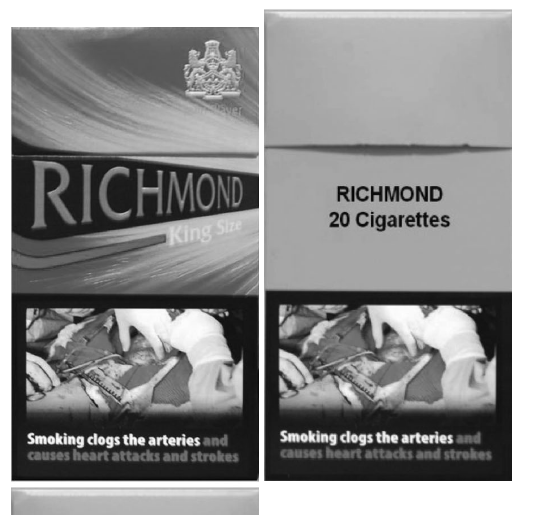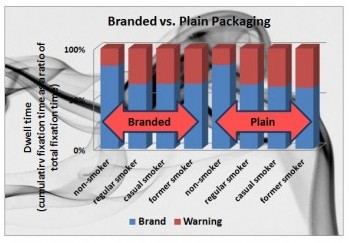Difference between revisions of "Standardised packaging"
Paul Herring (talk | contribs) |
Paul Herring (talk | contribs) |
||
| Line 17: | Line 17: | ||
The surveys were largely about what teenagers think they'd do, and not what they'd actually do, with regard to plain packaging. | The surveys were largely about what teenagers think they'd do, and not what they'd actually do, with regard to plain packaging. | ||
| − | ==Department of Health(2008)== | + | ==[[Department of Health (2008)]]== |
| − | + | Entitled Consultation on the future of tobacco control, aimed at "PCT CEs, NHS Trust CEs, SHA CEs, Foundation Trust CEs, Medical Directors, Directors of PH, Directors of Nursing, Local Authority CEs, Communications Leads," this report came up with a lot of conclusions that contained the words 'may,' 'might,' 'could' and other weasel words. | |
| − | + | It was also very selective in quoting parts of other research, while ignoring the parts that contradicted the, perceived, desired outcome for this report. | |
| − | |||
| − | |||
| − | |||
| − | |||
| − | |||
| − | |||
| − | |||
| − | |||
| − | |||
| − | |||
| − | |||
| − | |||
| − | |||
| − | |||
| − | |||
| − | |||
| − | |||
| − | |||
| − | |||
| − | |||
| − | |||
| − | |||
| − | |||
| − | |||
| − | |||
| − | |||
| − | |||
| − | |||
| − | |||
| − | |||
| − | |||
| − | |||
| − | |||
| − | |||
| − | |||
| − | |||
| − | |||
| − | |||
| − | |||
| − | |||
| − | |||
| − | |||
| − | |||
| − | |||
| − | |||
| − | |||
| − | |||
| − | |||
| − | |||
| − | |||
| − | |||
| − | |||
| − | |||
| − | |||
| − | |||
| − | |||
| − | |||
| − | |||
| − | |||
| − | |||
| − | |||
| − | |||
| − | |||
| − | |||
| − | |||
| − | |||
| − | |||
==The 'University of Bristol' Study== | ==The 'University of Bristol' Study== | ||
Revision as of 20:04, 12 March 2012
Plain packaging is intended, according the the anti-smoking proponents, to reduce the number of people (some claims state 'children,' instead of people) taking up smoking because it will "make them less attractive."
Others have pointed out that plain packaging lowers the existing barriers to counterfeiting by allowing the counterfeiters to not bother too hard with one aspect of making fake cigarrettes.
J Padilla & N Watson (2008)
Commissioned for Phillip Morris International (PMI), by The Law and Economics Consulting Group(LECG) to review previous research on the subject of generic (plain) packaging, largely with regard to teenagers. It concludes that none of those papers reviewed could provide a reliable basis on which to determine if plain packaging would reduce smoking levels.
M Goldberg, et al. (1995)
A report for Health Canada, of teenagers, over 5 different studies, to examine the potential effect plain packaging might have on
- the uptake of smoking to begin with,
- the impact on the recognition of, and the ability to remember, the warnings on packaging,
- the probability of stopping smoking
The surveys were largely about what teenagers think they'd do, and not what they'd actually do, with regard to plain packaging.
Department of Health (2008)
Entitled Consultation on the future of tobacco control, aimed at "PCT CEs, NHS Trust CEs, SHA CEs, Foundation Trust CEs, Medical Directors, Directors of PH, Directors of Nursing, Local Authority CEs, Communications Leads," this report came up with a lot of conclusions that contained the words 'may,' 'might,' 'could' and other weasel words.
It was also very selective in quoting parts of other research, while ignoring the parts that contradicted the, perceived, desired outcome for this report.
The 'University of Bristol' Study
One citation for this claim is the study entitled Plain packaging increases visual attention to health warnings on cigarette packs in non-smokers and weekly smokers but not daily smokers by Marcus R. Munafò, Nicole Roberts, Linda Bauld & Ute Leonards. The title of the study pretty much sums up the findings of the study which basically involved studying the (dominant) eye movements of 15 non-smokers (never smoked more than 100 cigarettes in their life), 14 'weekly' smokers (at least one per week, but not daily) and 14 daily smokers (at least one per day.)
Specifically, they measured how long people looked at the warning messages on both plain and branded packs, and the difference in amount of time between the types of packs and the types of smokers.
Participants were instructed that they'd be shown some images in the first phase of the experiment, and would have to indicate whether or not any images presented in the second phase were present in the first.
The first phase consisted of (randomly) 10 images of plain packs and 10 images of branded packs with 10 warnings (one per type of pack) present and each image was shown for 10 seconds.
The second phase, was 10 images from phase 1, and 10 new images (with each set of 10 having 5 plain and 5 branded packs, and 5 warnings,) and the participants given 5 seconds per image to decide if it was present in phase 1 or not.
Eye movements were tracked in only the first phase.
As summarised by the study's titile, they found that the non- and weekly- smokers tended to look at the warning more if the pack was plain than if it was branded.
Problems with the Bristol Study
The images used
On page 3 of the linked pdf (page '1507' as marked on the pages) there is an image that is described as
- Figure 1 Examples of branded and plain pack stimuli. Example visual stimuli designed specifically for the purposes of this study are shown. Branded pack images (top) were taken from popular ciga rette brands in the United Kingdom. Plain white pack images (bottom) were taken from an example plain pack created for Action on Smoking and Health (England)
The image is reproduced here, with the bottom (plain) packet cropped off (but not entirely,) and copied to the right of the branded packet:
Note that (as apparently presented in the study) the packets are the same width, they are not the same height.
The participants
The number of participants (43, selected by adverts in and round the university campus,) while probably ideal for a feasibility study as to whether more research is needed, is pitifully small for a piece of research on which so many arguments about plain packaging appear to rest.
Additionally, for those relying on this study arguing for banning branded packaging 'for the sake of the children,' the average ages for the three groups were 23, 24 and 24 (for non-,weekly, daily respectively.) The youngest interquartile participant was 21, the oldest 28.
The male/female breakdown shows another skew:
Not that these actual numbers are actually presented in the study - they give percentages (71% of 14 daily smokers were male for example (which is 9.94.))
| Group | Male | Female |
|---|---|---|
| Non smokers | 10 | 5 |
| Weekly smokers | 9 | 5 |
| Daily smokers | 10 | 4 |
| Total | 29 | 14 |
Royal Holloway, University of London project
While nothing as grand as a 'study' with a published paper such as the University of Bristol study appears to pretend to be, Tim Holmes has been supervising a study by his 3rd year psychology students[1]. In his own words:
- We invited 59 non-smokers, regular smokers, social smokers (the ones who maybe smoke just on a Friday evening after a couple of drinks) and ex-smokers (who have given up for at least 6 months) to look at examples of 4 different package designs including regular branding, 2 types of picture warning labels and plain packaging. We tracked the participants’ eye-movements using a Tobii X120 eye-tracker, and showed each design with 4 different warning messages for 10 seconds each. We also asked participants to evaluate the risks associated with smoking before and after viewing the 16 packages. Unsurprisingly non-smokers tended to perceive a greater risk from smoking than the other 3 groups and disappointingly there was no change in risk perception as a result of viewing the stimuli.
- To be honest, our initial hypotheses all related to the picture messages and in the best research tradition returned non-significant results! However, we were surprised to observe two interesting results: the non-smokers looked at the warning messages much less than the other participants, and there was no difference between plain and branded package designs in the amount of time spent looking at the warning message. Now, it’s great that the right people are looking more at the warning message, but if this doesn’t result in an increased risk perception then surely the messages aren’t doing their job! Moreover, if removing the brand identity doesn’t change the way people look at the packets then maybe plain packaging, which will be costly to implement, isn’t the best of ideas.

